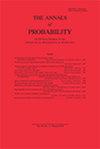ising模型的截止的通用性
IF 2.5
1区 数学
Q1 STATISTICS & PROBABILITY
引用次数: 25
摘要
根据Dobrushin和Holley在20世纪70年代的经典结果,在任何局部有限几何上,当逆温度ββ足够小时,随机Ising模型已知是收缩的。根据佩雷斯提出的一般原理,预计动力学会出现截止。然而,到目前为止,伊辛模型的截止主要是对格的确认,严重依赖于可修正性和对数Sobolev不等式。没有这些,在任何固定的β>0β>0处都是未知的,无论多小,即使是在基本的例子中,如二叉树或随机正则图上的Ising模型。我们使用信息渗透的新框架来表明,在任何几何中,在足够高的温度下,伊辛模型都有一个截止点。准确地说,对于任何具有最大度dd的图序列,如果β<κ/dβ<κ/d对于某个绝对常数κκ(在κκ的值之前,这是最好的结果),则Ising模型具有截断性。将截止位置确定为磁化平方和降为1的时刻,截止窗口为O(1)O(1),与β=0β=0时相同。最后,几乎所有初始状态的混合时间都不超过最差状态的1+eβ1+eβ的1倍(其中eβ→0eβ→0和β→0β→0),而均匀起始状态的混合时间至少快2−eβ2−eβ的1倍。本文章由计算机程序翻译,如有差异,请以英文原文为准。
Universality of cutoff for the ising model
On any locally-finite geometry, the stochastic Ising model is known to be contractive when the inverse-temperature ββ is small enough, via classical results of Dobrushin and of Holley in the 1970s. By a general principle proposed by Peres, the dynamics is then expected to exhibit cutoff. However, so far cutoff for the Ising model has been confirmed mainly for lattices, heavily relying on amenability and log Sobolev inequalities. Without these, cutoff was unknown at any fixed β>0β>0, no matter how small, even in basic examples such as the Ising model on a binary tree or a random regular graph.
We use the new framework of information percolation to show that, in any geometry, there is cutoff for the Ising model at high enough temperatures. Precisely, on any sequence of graphs with maximum degree dd, the Ising model has cutoff provided that β<κ/dβ<κ/d for some absolute constant κκ (a result which, up to the value of κκ, is best possible). Moreover, the cutoff location is established as the time at which the sum of squared magnetizations drops to 1, and the cutoff window is O(1)O(1), just as when β=0β=0.
Finally, the mixing time from almost every initial state is not more than a factor of 1+eβ1+eβ faster then the worst one (with eβ→0eβ→0 as β→0β→0), whereas the uniform starting state is at least 2−eβ2−eβ times faster.
求助全文
通过发布文献求助,成功后即可免费获取论文全文。
去求助
来源期刊

Annals of Probability
数学-统计学与概率论
CiteScore
4.60
自引率
8.70%
发文量
61
审稿时长
6-12 weeks
期刊介绍:
The Annals of Probability publishes research papers in modern probability theory, its relations to other areas of mathematics, and its applications in the physical and biological sciences. Emphasis is on importance, interest, and originality – formal novelty and correctness are not sufficient for publication. The Annals will also publish authoritative review papers and surveys of areas in vigorous development.
 求助内容:
求助内容: 应助结果提醒方式:
应助结果提醒方式:


